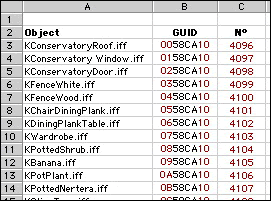

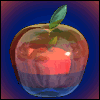
|
Home
|

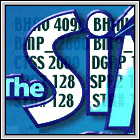
| IFFSnooper ... |

| This part of the process is a bit boring, but it is extremely important to know about Magic Cookies
especially if you are going to share or post any of your objects. Every object in the Sims has a unique identification number which your game uses to 'catalogue' the Maxis objects and any objects you have in your downloads folders. If two or more objects have the same number, the game will only show ONE of those objects. |
| A printable Magic Cookies Quick Reference sheet is here. (The page will open in a new window.) |
|
& Magic Cookies |
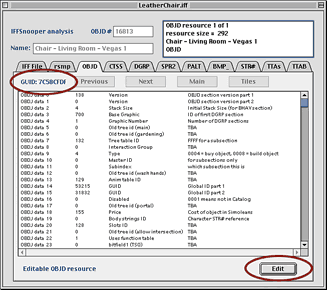
| When you've re-coloured an object you need to give it a different ID number so that it shows up in
your game. This is called the Globally Unique ID (GUID) number and you can see it by clicking on the OBJD tab in IFFSnooper.
It is written in hexadecimal (just pretend you've got 16 fingers!), but don't worry — you won't need to learn
how to count in hex. |
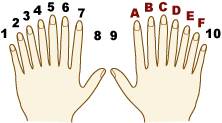 |
|
So that people could re-colour or create new objects and not use each other's object IDs by mistake, a part of the GUID was designated as the Magic Cookie number. Each creator would be assigned one Magic Cookie number to use for all his/her objects — that way, there wouldn't be any ID conflicts. |
| Let's say that my Magic Cookie Number is 22730. |
| Decimal Hex |
|
22730 = 58CA
|
| In the OBJD screen, click the Edit button. Another screen will appear — it's where you can
change the categories for an object. It's also where you can enter a Magic Cookie and alter the GUID number. If you type a Magic Cookie number into the cookie 'box' (and then press TAB or click in another box) you will see how the GUID number changes. |
|
The other four digits, DF and 7C, make up the part of the number that will change if you clone your object to create a new GUID, but first close the OBJD Edit screen, and go to the File Menu. |

|
Magic Cookie Confusion |
| You must remember to save the object after any changes — IFFSnooper will not remind you. |
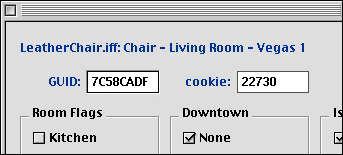
| You are going to have to keep track of your own GUID numbers. Why not write them down in that notebook you always keep beside your computer for jotting down passwords, game tips, serial numbers, Formula One results, URLs ... those sorts of things. Start a page for your objects. |
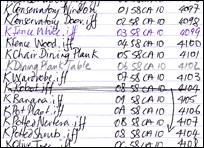
| Or, you might be very organised and keep a spreadsheet with the information. If you're gung-ho with Excel you can use the HEX2DEC( ) function. |
| These days, all you can really do is pluck a Magic Cookie number out of the air — any number
between 0 and 65,535. There are two sites which have attempted to create a list of Magic Cookie numbers. I strongly advise you to search through these lists to make sure that the number you have chosen is not being used by someone else ... like SimFreaks or 7DS or Around the Sims or Raveena or Miffy ... or me! These lists are not complete in any way, but at least it gives you a start. Magic Cookies Database — a Yahoo! eGroup Sandshifter's Identify Note: It's a bit difficult to work out some people's Magic Cookie numbers if they are using numbers greater than 65,535 because they are on that 'second time around'. Just concentrate on their numbers written in hex — they are usually correct. And while you're there, add your own number. |
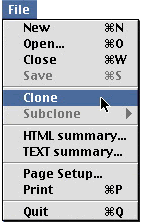


|
Before
|
|
After
|
| You might want to be able to convert numbers from hex to decimal and back, so you will need to use
a binary calculator. I use a freeware one called BinCalc written by R Fronabarger ©1998. You can download
it from Macware.Erewhon
(either use the alphabetical listing or find it under the Programming category). It looks terribly complicated but
all you need to do is type in your decimal or hex number to see its conversion. |
 |
Or check out the shareware/freeware sites like Tucows or Shareware.com. |
| eg. the formula in C10 is =HEX2DEC(RIGHT(B10,2)&LEFT(B10,2)) |
| Don't get confused: If you also have access to some of the Wintel Sims' utilities, be aware that a couple of them display the GUID's bytes in reverse order. |
|
|
IFFSnooper TMog IFFPencil SimCategoriser Object ID |
7C 58 CA DF 7C 58 CA DF 7C 58 CA DF DF CA 58 7C DF CA 58 7C |
| Jump to the beginning |
| You cannot enter a Magic Cookie number greater than 65,535 (FF FF). If you do, IFFSnooper will readjust
the hex to a 'less than 65,535' number — you'll see its decimal equivalent the next time you open the object
(and it may belong to someone else). If you really, really want to know what's happening, a number like 100,000 will end up as 34,464 — that's 100,000 minus 65,536 = 34,464. |

| Stop Press! |
| Now there is an ID checker for the Macintosh! It will list all the objects with their GUID numbers
in any folder, including sub-folders — it will even find objects in .far files too. Clicking an 'analyse' button
will bring up a list of any duplicate numbers present which you can edit, right there and then. Go NOW to Sandy's website, Around the Sims, and look on the Mac Help pages for the Sims-GUID-Checker. It's wonderful! |